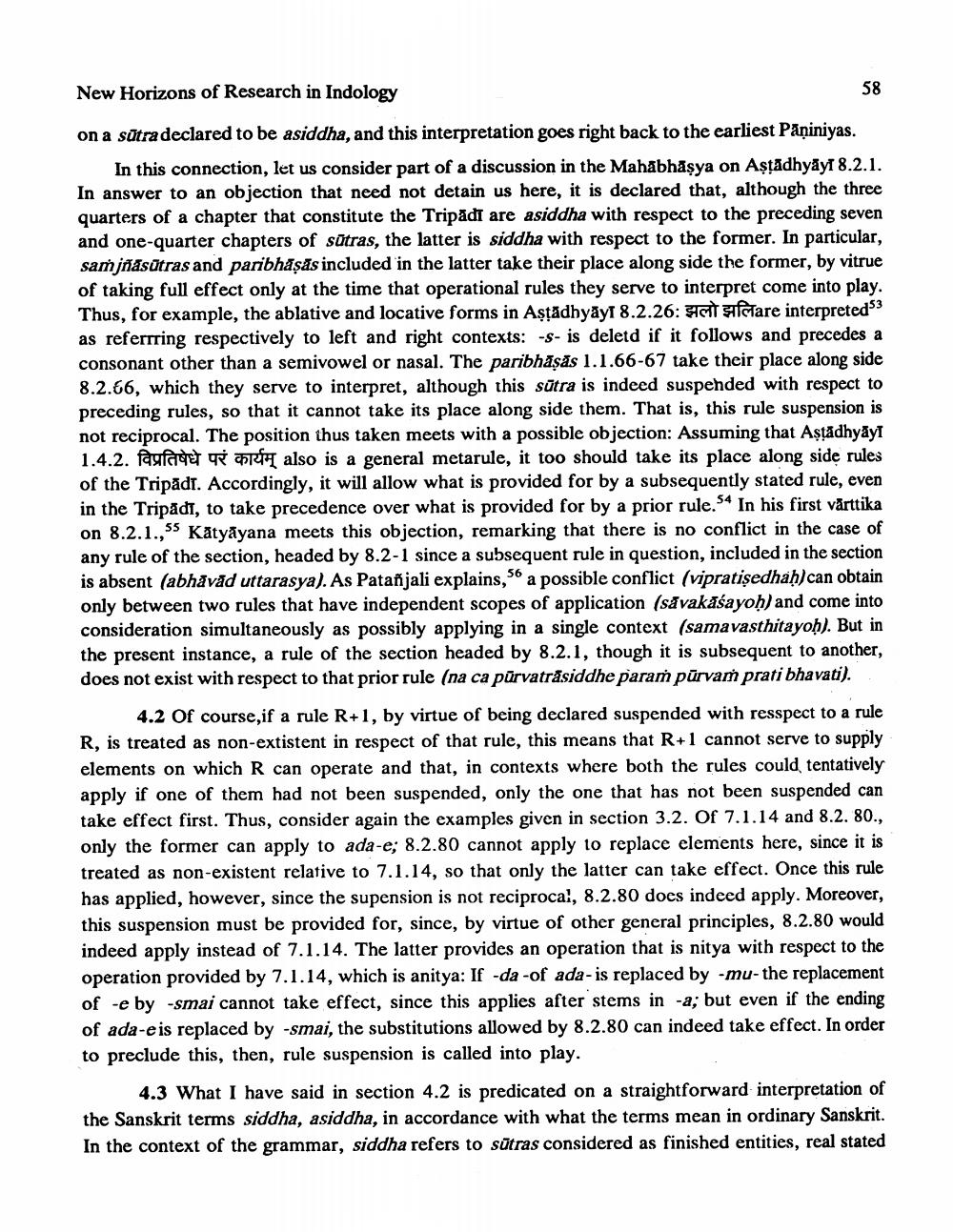________________
New Horizons of Research in Indology
on a sūtra declared to be asiddha, and this interpretation goes right back to the earliest Pāṇiniyas.
In this connection, let us consider part of a discussion in the Mahabhäşya on Astādhyāyr 8.2.1. In answer to an objection that need not detain us here, it is declared that, although the three quarters of a chapter that constitute the Tripadi are asiddha with respect to the preceding seven and one-quarter chapters of sūtras, the latter is siddha with respect to the former. In particular, samjñāsūtras and paribhāṣās included in the latter take their place along side the former, by vitrue of taking full effect only at the time that operational rules they serve to interpret come into play. Thus, for example, the ablative and locative forms in Aşțădhyāyt 8.2.26:
S istare interpreted 3 as referring respectively to left and right contexts: -s- is deletd if it follows and precedes a consonant other than a semivowel or nasal. The paribhāṣās 1.1.66-67 take their place along side 8.2.66, which they serve to interpret, although this sūtra is indeed suspended with respect to preceding rules, so that it cannot take its place along side them. That is, this rule suspension is not reciprocal. The position thus taken meets with a possible objection: Assuming that Așțădhyāyi 1.4.2. fagfaget op Af also is a general metarule, it too should take its place along side rules of the Tripādī. Accordingly, it will allow what is provided for by a subsequently stated rule, even in the Tripadi, to take precedence over what is provided for by a prior rule.54 In his first värttika on 8.2.1.,55 Kätyāyana meets this objection, remarking that there is no conflict in the case of any rule of the section, headed by 8.2-1 since a subsequent rule in question, included in the section is absent (abhāvăd uttarasya). As Patañjali explains, 56 a possible conflict (vipratişedhaḥ) can obtain only between two rules that have independent scopes of application (savakāśayoḥ) and come into consideration simultaneously as possibly applying in a single context (samavasthitayoh). But in the present instance, a rule of the section headed by 8.2.1, though it is subsequent to another, does not exist with respect to that prior rule (na ca pūrvatråsiddhe paraṁ pūrvaṁ prati bhavati).
4.2 Of course, if a rule R+1, by virtue of being declared suspended with resspect to a rule R, is treated as non-extistent in respect of that rule, this means that R+1 cannot serve to supply elements on which R can operate and that, in contexts where both the rules could tentatively apply if one of them had not been suspended, only the one that has not been suspended can take effect first. Thus, consider again the examples given in section 3.2. Of 7.1.14 and 8.2. 80., only the former can apply to ada-e; 8.2.80 cannot apply to replace elements here, since it is treated as non-existent relative to 7.1.14, so that only the latter can take effect. Once this rule has applied, however, since the supension is not reciprocal, 8.2.80 docs indeed apply. Moreover, this suspension must be provided for, since, by virtue of other general principles, 8.2.80 would indeed apply instead of 7.1.14. The latter provides an operation that is nitya with respect to the operation provided by 7.1.14, which is anitya: If -da -of ada-is replaced by -mu-the replacement of -e by -smai cannot take effect, since this applies after stems in -a; but even if the ending of ada-eis replaced by -smai, the substitutions allowed by 8.2.80 can indeed take effect. In order to preclude this, then, rule suspension is called into play.
4.3 What I have said in section 4.2 is predicated on a straightforward interpretation of the Sanskrit terms siddha, asiddha, in accordance with what the terms mean in ordinary Sanskrit. In the context of the grammar, siddha refers to sūtras considered as finished entities, real stated




